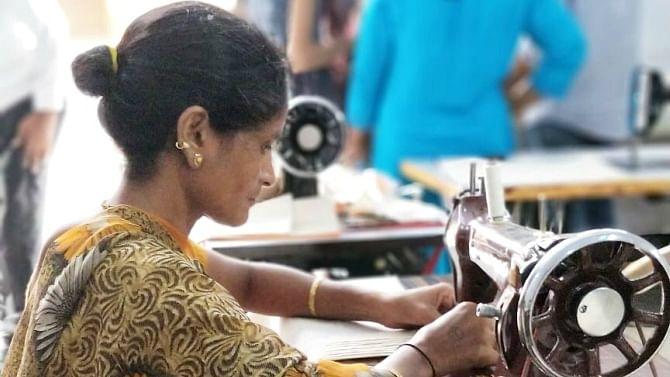COVID-19: Home-based Workers in Delhi Hit Hard, Making Less Than Rs 10 Per Day

Representational Image. Image Courtesy: National Herald
Six months into the COVID-19 pandemic, the informal sectors workers in Delhi—who are among the hardest hit—are struggling to find their voices. These include the home-based workers engaged in the production of garments for bigger brands and smaller factories. With supply chains broken and no contacts in store, the sources of income for these workers—a large section of which is residing in North East Delhi, that was ravaged by communal violence earlier this year—have dried up. They find themselves trapped in a cycle of scrambling for food, debt and no social security from the state.
‘Condition so dire, I want to hang myself’
Soni is a young widow in the riot affected area of Bhajanpura. She was engaged in making birthday banners and adding borders on garments to earn her living. However, since the pandemic began things have changed. She said, “I would get free cooked meals earlier but now there is nothing. I borrow milk from neighbours for my children. Those who had given orders are not paying me for my labour. There is no one I can approach for help.”
She added, “My income has gone to an absolute zero.”
Another resident of Bhajanpura, Baby and her husband used to provide home produced garments at a factory which was set on fire during the communal violence in the last week of February.
She told NewsClick, “We have absolutely no income since the riots struck. The Hindu-,uslim relationship remains strained which has affected our orders. Our work is based a lot on relationships since ours is not a formal job.”
She added, “My children have to lie to moneylenders, I have to ask them to tell them off. I am constantly trying to hide myself because of the loans that we have taken. Our condition is so dire, I want to hang myself.”
A study by labour rights organisation Aajeevika Bureau found that home-based workers are working for as little as Rs 10-15 for over eight hours a day during the pandemic, in the face of employers’ apathy and the lack of access to urban welfare schemes.
Also watch: Delhi's Home Based Workers:Invisible and Unpaid
The situation of some workers is even more chronic in North East Delhi, as they have not received work for a long time. First, due to the communal riots in these areas and now due to the lockdown.
Commenting on the worsening condition of these workers, activist Shalini Sinha said, “Two things have happened, there are some home based workers who used to make things at home and sell it in the markets. with no market revival in sight the pandemic has hit these workers the most. The second aspect is for those who used to get orders from outside. With supply chains broken, there are no new orders and the previous orders have not been picked up.”
She explained, “Workers are extremely worried about the rent that they have to pay. Additionally with the children at home and husbands not going to work, the women find themselves trapped. The stark invisibility of the sector has become much worse.”
“The textile and garments industry, where most women were employed, contributes 2.3% to India’s gross domestic product, 7% to its manufacturing output and 13% to its export earnings. Since most female home-based workers earn their living in their home, what work they do, and the effort and the time spent goes unnoticed. The work that these women do in their houses is therefore left invisible in the eyes of the community, but also in the law and policy makers as these women are not even recognised as workers,” she added.
According to the Periodic Labour Force Survey 2017-18, there are 30 million home-based workers (HBW) in India. However, as per various organisations working for home-based workers, this is a serious underestimation of HBW in India. Around 50% of them are employed in manufacturing. Within manufacturing, it is the apparel and textile industry which employs more than 52% (7.8 million) of the HBW workers.
NewsClick has previously reported on the issue to highlight how home-based work remains the least visible workforce, rarely featuring in any governmental programme or policy.
Additionally home-based workers remain at serious disadvantage even in comparison to most other workers that fall under the category of unorganised sector. As the workers lack the ability to hold any bargaining power with the contractors, they are often isolated within the home, with limited opportunities to interact with other home-based workers, which has worsened during the pandemic.
Get the latest reports & analysis with people's perspective on Protests, movements & deep analytical videos, discussions of the current affairs in your Telegram app. Subscribe to NewsClick's Telegram channel & get Real-Time updates on stories, as they get published on our website.
























